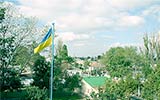Ukraine
Landscape, climate and water flow
The largest part of the river basin in Ukraine lies in the Carpathian Mountains. The Danube itself flows through the lower part of Ukraine and is divided into three branches, one of which – the Kiliya – forms the border between Ukraine and Romania. The region enjoys mild winters and summers. Annual precipitation in the mountains is around 1,750 mm and 700 mm in the lowlands.
The Danube Biosphere Nature Reserve is home to more than 250 species of birds?
Natural highlights include:
The Danube Biosphere Nature Reserve of the National Academy of Sciences of Ukraine, is located at the Kiliya branch of the Danube in the Delta. With a total area of approximately 46,000 ha, protected areas include islands with attached areas of water and wetlands. More than 5,000 animal species live in the reserve, including pink pelicans, geese, dolphins, seal-monks, true otters and minks.
Human Uses
The largest part of the Tisza and Prut sub-basins is covered by forests; the rest of the land is used for agriculture, human settlements and infrastructure. There are several hydropower stations in the Tisza Basin, with a total capacity of 31,600 kWt. The Tisza River Basin in Ukraine is rich in groundwater bodies, both alluvial and karstic waters. More than 60% of the centralised drinking water supply comes from groundwater sources.
While the rivers of the Tisza and Prut Basins cannot be used for navigation, Ukraine is united with Europe by the Danube River. However, only a quarter of the potential shipping capacity on the Ukrainian part of the Danube is used. Currently, Ukraine is working to make the existing natural branches of the Danube River suitable for navigation. These activities, however, are under debate in Ukraine.
The Tisza and Prut are mountain rivers in Ukraine, and floods are therefore common. The biggest floods on the Tisza occurred in November 1998 and March 2001, when the highest water levels were recorded. Much has been done since then to improve flood protection, including installing automatic gauging stations.
Pollution
Rivers in Ukraine are used as receiving waters for both urban and industrial wastewaters, although exact data on pollution is currently unavailable.
For detailed information on the above, download the fact sheet below.
Disclaimer
The information contained in the ICPDR website is intended to enhance public access to information about the ICPDR and the Danube River. The information is correct to the best of the knowledge of the ICPDR Secretariat. If errors are brought to our attention we will try to correct them.
The ICPDR, expert group members, nor other parties involved in preparation of information contained on this website cannot, however, be held responsible for the correctness and validity of the data and information provided, nor accept responsibility or liability for damages or losses arising directly or indirectly from the use of the information conveyed therein.
Only those documents clearly marked ICPDR documents reflect the position of the ICPDR.
Any links to other websites are provided for your convenience only. The ICPDR does not accept any responsibility for the accuracy, availability, or appropriateness to the user's purposes, of any information or services on any other website.
When using the information and material provided on this website, credit should be given to the ICPDR.

